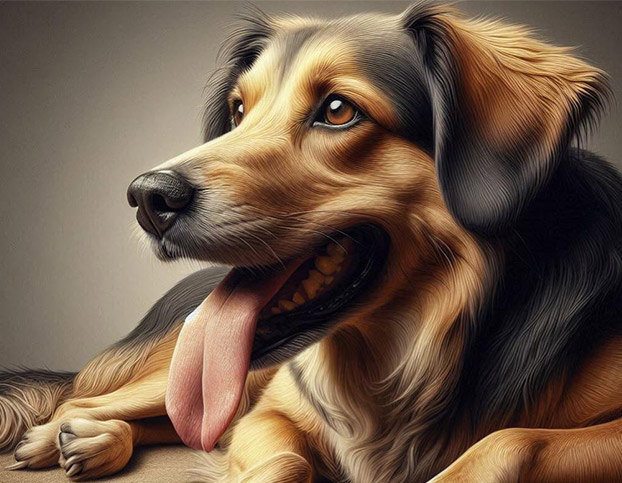It’s a concern if your dog is panting excessively when resting, when it’s not hot and if they haven’t been exercising. Panting is a dog’s primary way of cooling down, so when it happens without an obvious heat or exercise-related cause, it often indicates an underlying medical issue.
Here are some common causes of dog panting at rest, not related to heat or exercise:
Respiratory Issues
Lung Disease: Conditions like pneumonia, bronchitis, pulmonary fibrosis, pulmonary thromboembolism (PTE), pulmonary hypertension (PH) or lung cancer can make it difficult for a dog to get enough oxygen, leading panting.
Pleural Effusion: Fluid buildup in the space around the lungs can compress the lungs, increasing the effort needed to inhale and making breathing difficult.
Pulmonary Edema: Fluid buildup within the lungs, often due to heart failure, can cause panting and difficulty breathing. Other causes of pulmonary edema include acute strangulation, smoke inhalation and near drowning.
Laryngeal Paralysis: The larynx (voice box) doesn’t open properly during breathing, obstructing airflow and causing noisy breathing and panting. This is more common in older, large-breed dogs. This is typically accompanied by the typical “stridorous” breathing sounds.
Tracheal Collapse: The windpipe weakens and flattens, making it hard to breathe. This is more common in small breeds and typically is accompanied by a “goose honk’ type of cough during exercise or excitement.
Heart Issues
Congestive Heart Failure (CHF): When the heart isn’t pumping efficiently, fluid can back up into the lungs (pulmonary edema), leading to shortness of breath and panting.
Pericardial Effusion: This is a condition where fluid accumulates within the tight sac that envelopes the heart. As this fluid builds up, the pressure increases and compresses the heart which causes a form of heart failure.
Congenital Heart Disease: Certain birth defects affecting the heart can cause breathing changes, including Patent Ductus Arteriosis (PDA) and Tetralogy of Fallot.
Cardiac Arrythmia: Abnormal heart rhythm (such as atrial fibrillation) can cause panting in dogs.
Do not try to diagnose or treat your dog at home.
Pain and Anxiety
Pain: Internal pain (e.g., abdominal pain) or even arthritis discomfort, can cause a dog to pant.
Anxiety and Stress: Severe anxiety or stress can sometimes manifest as panting, even when the dog is resting. May be accompanied by other signs of anxiety like pacing, whining, or restlessness.
Metabolic and Endocrine Disorders
Anemia: A low red blood cell count means less oxygen is being carried to the tissues, which can lead to panting.
Cushing’s Disease (Hyperadrenocorticism): This condition involves an overproduction of cortisol, which can cause various symptoms, including increased panting.
Hyperthyroidism: While more common in cats, an overactive thyroid can sometimes occur in dogs and lead to increased metabolism and panting.
Diabetes mellitus: A severe form of unregulated diabetes called Diabetes Ketoacidosis (DKA) can cause panting.
Other Medical Conditions
Fever: An elevated body temperature can cause panting as the body tries to cool down.
Abdominal Distension: Stomach bloat, abdominal fluid (ascites), large liver or spleen tumors, or other conditions causing significant pressure in the abdomen can make it harder for the lungs to expand fully.
Certain Medications: Some medications can have panting as a side effect (e.g., prednisone).
Heatstroke (even if you don’t think it’s hot): Sometimes, the effects of a recent heatstroke can linger and cause ongoing issues with thermoregulation. If your pet has been in the heat and can’t seem to stop panting, heat stroke may be occurring which needs to be evaluated by a veterinarian quickly.
Obesity: Morbidly overweight dogs can pant (Pickwickian syndrome).
What Kinds of Tests are Needed
Your veterinarian will perform a thorough physical examination (including taking your pet’s temperature), ask about your dog’s history and other symptoms, and potentially recommend diagnostic tests such as:
Blood work: To check for anemia, infection, organ function, and endocrine disorders.
Urinalysis: To assess kidney function and look for other abnormalities such as protein loss (proteinuria), blood or white blood cells or glucose (sugar).
Radiographs (X-rays) of the chest and neck: To evaluate the lungs, heart and throat.
Echocardiogram (ultrasound of the heart): If heart disease is suspected.
Pulse oximetry: To measure the oxygen saturation in the blood.
Ultrasound: If abnormal fluid (pericardial, pleural or abdominal) or a tumor is suspected, ultrasound imaging can provide clarity as to the cause.
Panting in Cats. Be Aware!
Although this is a dog-related blog, it is important to mention that any panting in cats should be taken seriously and should cause prompt veterinary evaluation. Cats are considered obligate (or “preferential”) nasal breathers. Open-mouth breathing in cats is generally a sign of severe distress or a serious medical issue. It can indicate congestive heart failure, overheating, stress, severe pain, or underlying respiratory problems like asthma or upper airway obstruction. Panting in cats is less common than in dogs but should absolutely be evaluated quickly.
Don’t Panic. Contact Us.
Do not try to diagnose or treat your dog at home. Panting at rest in the absence of heat or exercise is a symptom that needs professional veterinary attention to determine the underlying cause and provide appropriate treatment. If you have concerns about how your dog is breathing, contact us and we can help.

Author:
James Woods DVM, MS, DACVIM (SAIM)
Ph: (912) 721-6410
Contact Us
